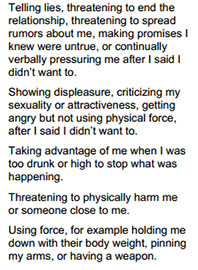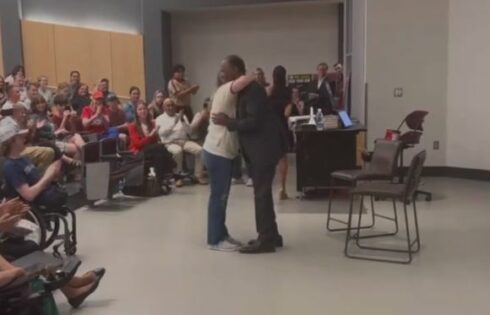
A new report on sexual assault by University of Oregon researchers claims that sorority women are twice as likely to be sexually assaulted as non-sorority women and more than three times as likely to be the victim of rape or attempted rape.
It also says that one in 10 women at the school have been raped.
What may be most notable about the survey, though, are its definitions, response rate and composition of respondents.
‘Self-selection’ and missed targets
The survey’s main takeaway at the school and in the media has been the sexual risks of Greek life. It claims that almost 50 percent of sorority women are victims of “non-consensual sexual experiences” along with about 25 percent of fraternity members, findings that led a school task force to propose a halt to the expansion of Greek organizations.
Yet as previously reported by The College Fix, the survey included twice as many women as men and was filled out by roughly 5 percent of the student population. The most prevalent category of sexual violence, according to the raw figures, was “fondling,” accounting for about 28 percent of women, followed by attempted vaginal assault at 12.5 percent.
 The preliminary results released by Jennifer Freyd, a UO psychology professor and sexual violence expert, and her team showed they missed their survey targets.
The preliminary results released by Jennifer Freyd, a UO psychology professor and sexual violence expert, and her team showed they missed their survey targets.
Aiming for a survey population that was 53 percent women and 63 percent white, responding students were instead 66 percent women and 74 percent white. Students ages 18-19 were overrepresented and those ages 22-23 underrepresented, both by several percentage points.
This means there was “likely self-selection based on response to topic matter,” the results said – in other words, students with stronger views on sexual assault were more likely to respond. The researchers also note their survey method hasn’t been “formally peer reviewed.”
Definitions and options for assault
Carly Smith, a doctoral student and one of the researchers, told The College Fix by email that their definition of rape comes from the Sexual Experiences Scale (SES). The SES defines rape as “Someone inserted their penis, fingers, or objects into my vagina without my consent” or “Someone inserted their penis, fingers, or objects into my anus without my consent.”
The figures for rape or attempted rape ranged from 15 percent of second-year women to 20 percent of fourth-year women at the school.
 When asked how they were assaulted or how someone tried to assault them, however, students were only given two options out of five that involved physical coercion – the use of threats or force.
When asked how they were assaulted or how someone tried to assault them, however, students were only given two options out of five that involved physical coercion – the use of threats or force.
One option says “too drunk or high to stop what was happening” – a subjective category that could run the gamut from drunk yet voluntary sex, to legally incapacitated – and the final two options involve nonviolent verbal coercion, such as “telling lies” or “criticizing my sexuality or attractiveness” to procure sex.
Sexual harassment was experienced by 57 percent of female undergraduates and 37 percent of male undergrads, according to the survey.
The survey uses a scale developed by the Department of Defense to measure sexual harassment, according to researcher Smith.
Examples of harassment include someone who “repeatedly told sexual stories or jokes that were offensive to you,” whose gestures or body language “of a sexual nature … embarrassed or offended you,” or who “treated you badly for refusing to have sex.”
Other forms of harassment include continually being asked out for dates “even though you said ‘No,’” feeling “threatened” with “retaliation for not being sexually cooperative” or feeling “bribed with some sort of reward or special treatment to engage in sexual behavior.”
There don’t appear to be any questions about the behaviors of the students answering the questions, such as whether they initiated the contact or their relationship if any with their alleged perpetrator.
Several well-documented cases of accused students who claimed they were innocent involved their former romantic partners, including that of former Yale quarterback Patrick Witt, now a Harvard Law student.
The definitions for “gender harassment” also include vague examples, such as being treated differently, offended by “sexist remarks,” put down “because of your gender” or “insulted” by someone talking about the opposite gender in “offensive terms.”
Under these definitions, the percentage of female students reporting gender harassment ranged from the low 40s to the high 60s depending on harassment type, while the percentage of men ranged from about 20 percent to the low 30s.
Task force recommendations: Stop Greek expansion, shower money on researchers
The survey results have already been cited in a report by the University Senate Task Force to Address Sexual Violence and Survivor Support, titled Twenty Students Per Week – a reference to the survey’s numerical finding on “all nonconsensual sexual contact.”
The task force is chaired by Carolyn Stabile, a women and gender studies professor at the university, but it’s unclear how involved Stabile actually is. According to an automatic email response, she is participating in a fellowship and unable to respond to emails until September 2015; the only way to reach her is by mail.
In response to the high figures of reported assaults against sorority women, the task force is recommending suspending the expansion of fraternities and sororities and developing mandatory courses on “gender, sexuality, and social inequality.”
It also recommends creating another task force for fraternity and sorority life, called the “FSL Sexual Assault Task Force.”
The task force cites a 2007 report on fraternities and sexual violence whose author recently told CNN: “Guys who joined a fraternity then committed three times as many sexual assaults as those who didn’t join. It is reasonable to conclude that fraternities turn men into guys more likely to rape.”
Researcher Smith told The Fix that her team is unsure on how to reduce assaults against sorority women.
“We are still looking at the results of our survey to determine patterns in who is victimizing these women,” Smith said. “Most are assaulted by men they know, and a lot of the assaults are taking place in relation to fraternity events.”
Another task force recommendation is to bring “award-winning” psychologist Mary Koss – whose 1987 study first introduced the “1 in 4” sexual assault figure – to speak at a university sexual violence conference next year, for which it’s requesting $77,000.
According to the report, Koss suggests that surveys should “assess the full range of sexually violent experience and tactics” which include “verbal coercion, penetration, contact and noncontact sexual acts, and incapacitation due to alcohol or drugs.”
The task force wants the school to pay $75,000 a year for Freyd, the psychology professor in charge of the sexual assault survey, and her graduate teaching fellows to keep doing surveys, travel to national conferences, pay survey participants and buy supplies.
Freyd did not return requests for comment.
“We are not commenting on the recommendations of the Senate Task Force until the full University Senate considers and acts upon the recommendations,” Justin Shukas, director of Fraternity and Sorority Life, told The Fix in an email.
Morgan Plew, president of the Panhellenic Council at UO deferred questions to Shukas, as did her counterpart Chase Salazar, president of the Inter-Fraternity Council.
College Fix reporter Matt Lamb is a student at Loyola University-Chicago.
Like The College Fix on Facebook / Follow us on Twitter
IMAGES: The UO Sexual Violence and Institutional Behavior Campus Survey




Please join the conversation about our stories on Facebook, Twitter, Instagram, Reddit, MeWe, Rumble, Gab, Minds and Gettr.